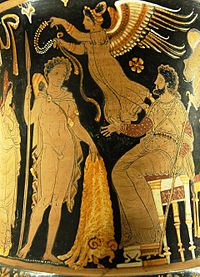Our website is made possible by displaying online advertisements to our visitors.
Please consider supporting us by disabling your ad blocker.
Golden Fleece

In Greek mythology, the Golden Fleece (Ancient Greek: Χρυσόμαλλον δέρας, romanized: Khrysómallon déras, lit. 'Golden-haired pelt') is the fleece of the golden-woolled,[a] winged ram, Chrysomallos, that rescued Phrixus and brought him to Colchis, where Phrixus then sacrificed it to Zeus. Phrixus gave the fleece to King Aeëtes who kept it in a sacred grove, whence Jason and the Argonauts stole it with the help of Medea, Aeëtes' daughter. The fleece is a symbol of authority and kingship.
In the historical account, the hero Jason and his crew of Argonauts set out on a quest for the fleece by order of King Pelias in order to place Jason rightfully on the throne of Iolcus in Thessaly. Through the help of Medea, they acquire the Golden Fleece. The story is of great antiquity and was current in the time of Homer (eighth century BC). It survives in various forms, among which the details vary.
Nowadays, the heraldic variations of the Golden Fleece are featured frequently in Georgia, especially for Coats of Arms and Flags associated with Western Georgian (Historical Colchis) municipalities and cities, including the Coats of Arms of City of Kutaisi, the ancient capital city of Colchis.
Cite error: There are <ref group=lower-alpha> tags or {{efn}} templates on this page, but the references will not show without a {{reflist|group=lower-alpha}} template or {{notelist}} template (see the help page).
Previous Page Next Page


